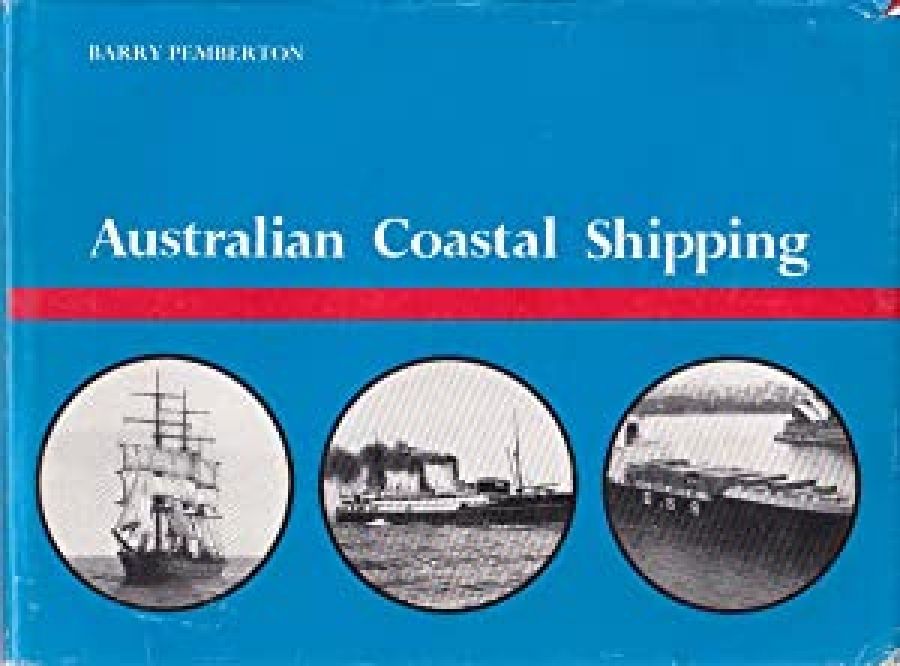
- Free Article: No
- Contents Category: Australian History
- Review Article: Yes
- Article Title: The business of seafaring
- Online Only: No
- Custom Highlight Text:
Until recently I had found that the most useful book on the history of shipping in the Australian area was the two-volume work Pageant of the Pacific by Captain F. Rhodes, published in 1936. During the last few years we have had several books devoted to single companies, such as the E. & A. Line, the AUSN, Adelaide Steamship, and smaller companies, each of which showed the difficulty of condensing a lot of ships histories into one volume. To deal with all the coastal companies, some of which extended overseas, in one volume, requires ruthless editing and carries the danger of the story being stripped of its flesh, to leave us with the dry bare bones. Two years ago there appeared the very complete work by Dr John Bach, A Maritime History of Australia in nearly 500 pages. The work under review is briefer and easier to read, being about 330 pages with 115 photographs and line drawings. A strange omission in both these books is that their bibliographies give no mention to Rhodes’ great work.
- Book 1 Title: Australian Coastal Shipping
- Book 1 Biblio: MUP $28.80, 327 pp
- Book 1 Cover Small (400 x 600):

The origin, rise and decline of various companies and trades is very well described, together with the different theories put forward to account for the extinction of certain trades, particularly the interstate passenger services immediately following the war. Many shipping services suffered from the rise in air-travel, and from the better services for cargo provided by road transport.
The author occasionally refers to Burns, Philp and Company as Philp’s, and as I served that firm for forty-two years, from cadet to commodore, I naturally checked the book accuracy in regard to that company’s ships. On looking up the name Bulolo in the ‘Index’, I found the reference given as page 213. This is an error for page 223, where a line drawing of the ship is given. The text describing this ship strangely omits her record of service during the war, and she is not given a mention in the chapter which gives the war services of other Australian ships. Actually the Bulolo was only a year old when she was called up for service in the Royal Navy, in September 1939. She had a worthy record as HMS Bulolo, serving first as an armed merchant cruiser, and then being converted into a headquarters ship for the allied landings and other combined operations around the Mediterranean. She was the headquarters ship for the landing at Normandy, where she had a direct hit from a German bomber. After repair she was again chosen by Mountbatten as his flagship for the Far East, where she served until the end of 1946. She was then refitted as a passenger ship and returned to Sydney to resume her service under the Burns, Philp flag to New Guinea from 1948–68.
In the chapter on overseas trades the old Montoro is stated to have been sold in 1926, upon the delivery of the new Malabar. Actually the old ship was not sold until 1948. As for the new Malabar it is stated that she was wrecked on 3 April 1931, and a good photograph shows her on the rocks at Long Bay, with the trawler Charlie Cam half-hidden by her bridge. The adjacent suburb was called Malabar after the wreck, but the date should have been given as the 2 April, not 3. In the Japanese raid on Darwin in 1942 it is stated that ‘Neptuna exploded into fragments’ after being bombed, but actually only the stern section blew up, owing to a cargo of mines in her after-holds. The main part of her hull rolled over on her side, and was converted by army engineers into a wharf which was used for about ten years afterwards.
Occasionally it is difficult to know what period the author is referring to, for example in the sentence: ‘The Fiji service was profitable until the Australian government banned the import on bananas.’ The AUSN began running to Fji in about 1887, and ended that trade in 1928. Their Pilbarra was on the run in 1905, when she lost her propeller while passing through the New Hebrides. The later ships were Suva and Levuka. Presumably the trade became unprofitable sometime prior to 1928.
In the chapter dealing with war service, it is sometimes difficult to tell which war is being referred to, though it is generally World War I. However ships from Australian lines had war service carrying troops from the Edina in the Crimean War, the Boer War, as well as the two World Wars, up to the smaller wars in the Far East in the 1960’s.
Despite these minor quibbles, it is a good book, well written and attractively produced, and brings the story right up to date for readers interested in modern types of ships.


Comments powered by CComment